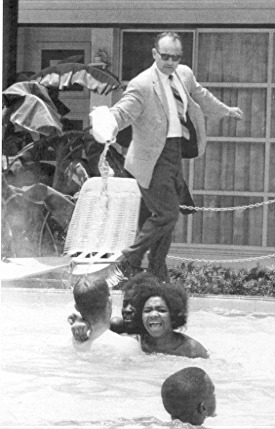This morning I went on a bit of a tear about the ludicrous idea of a ‘culture of poverty’. I suppose calling it ludicrous is not fair, since on the surface, if you’re ignorant of a lot of facts, the idea at least has some superficial credibility. What I didn’t get around to is the illustration of what might be a better explanation. It will probably come as an eye-rolling lack of surprise to most when I point to racism as a potential explanation. I am not referring simply to the active kind of racism whereby black and brown kids are discriminated against by teachers, or wherein employers don’t hire people with funny sounding names. No, the kind of racism I am referring to is far more structural and ephemeral than that.
Imagine you were born with a limp. In our modern society, that’s certainly not a major hurdle to overcome. We have, through conscious effort as a consequence of advocacy, built mechanisms into our infrastructure to allow people with mobility issues to live fulfilling and productive lives. We have actively reduced structural discrimination against people who, through no fault of their own, have a disadvantage. Now sure, you’re not going to be an Olympic sprinter or anything like that – your physical condition precludes that. But, there’s no reason you couldn’t be a physicist or a spot welder or any other occupation that doesn’t require extraordinary leg strength or mobility.
Contrast what your life would be like if you had been born with the same limp in, say, ancient Sparta. Because you would need full mobility to participate in even the basic parts of your society, you’d be in serious trouble. Not only would you be unable to access things you need to live, but you’d be excluded from involvement in social and political life – not because you couldn’t do them, but because you’d spend all your time struggling just to keep your head above water. Your inability to thrive would likely be seen as some kind of curse from the gods, or worse still as your own fault. If you want to succeed, you have to work harder than your more able-bodied peers to achieve anything.
These are the two different models of society we can contrast – one that puts the necessary effort to ensure that physical traits like a limp don’t preclude you from engaging in activities for which a limp is not a real handicap, and one in which no attempt is made to overcome a disability in such a way as to make it essentially impossible to participate even in those things that your disability doesn’t apply to.
Which society do you think we live in when it comes to race?
Click image to enlarge
I put it to you that being born black or hispanic puts you at a disadvantage. That being in one of these groups, even before we get into issues like a ‘culture of poverty’, places extra hurdles in your way. Not hurdles that are actually related to your success, but hurdles that prevent you from reaching it nonetheless. This kind of systemic racism operates in the background without any kind of conscious intent or active discrimination on behalf of a secret cabal of bigots. It has the same force as active racism though, since your racial identity is a strong predictor of your chances of success, even though this connection is highly erroneous.
The question we must ask ourselves is whether or not we’re interested in fixing this problem. If we’re content to allow this state of affairs to continue, then there’s no reason to make any changes. Of course, as I suggested before, this ends up hurting everyone. It would be much better for all members of society for there to be fewer poor people. If we’re interested in seeing that happen, then we have to work to reduce these inequalities. Otherwise we’ll have a segment of society still stuck behind the 8 ball, with no hope of getting ahead.
Like this article? Follow me on Twitter!


